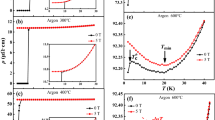Abstract
The Andreev subgap conductance at 0.08–0.2 K in thin-film superconductor (aluminum)–insulator–normal metal (copper, hafnium, or aluminum with iron-sublayer-suppressed superconductivity) structures is studied. The measurements are performed in a magnetic field oriented either along the normal or in the plane of the structure. The dc current–voltage (I–U) characteristics of samples are described using a sum of the Andreev subgap current dominating in the absence of the field at bias voltages U < (0.2–0.4)Δc/e (where Δc is the energy gap of the superconductor) and the single-carrier tunneling current that predominates at large voltages. To within the measurement accuracy of 1–2%, the Andreev current corresponds to the formula \({I_n} + {I_s} = {K_n}\tanh \left( {{{eU} \mathord{\left/ {\vphantom {{eU} {2k{T_{eff}}}}} \right. \kern-\nulldelimiterspace} {2k{T_{eff}}}}} \right) + {K_s}{{\left( {{{eU} \mathord{\left/ {\vphantom {{eU} {{\Delta _c}}}} \right. \kern-\nulldelimiterspace} {{\Delta _c}}}} \right)} \mathord{\left/ {\vphantom {{\left( {{{eU} \mathord{\left/ {\vphantom {{eU} {{\Delta _c}}}} \right. \kern-\nulldelimiterspace} {{\Delta _c}}}} \right)} {\sqrt {1 - {{eU} \mathord{\left/ {\vphantom {{eU} {{\Delta _c}}}} \right. \kern-\nulldelimiterspace} {{\Delta _c}}}} }}} \right. \kern-\nulldelimiterspace} {\sqrt {1 - {{eU} \mathord{\left/ {\vphantom {{eU} {{\Delta _c}}}} \right. \kern-\nulldelimiterspace} {{\Delta _c}}}} }}\) following from a theory that takes into account mesoscopic phenomena with properly selected effective temperature T eff and the temperature- and fieldindependent parameters K n and K s (characterizing the diffusion of electrons in the normal metal and superconductor, respectively). The experimental value of K n agrees in order of magnitude with the theoretical prediction, while K s is several dozen times larger than the theoretical value. The values of T eff in the absence of the field for the structures with copper and hafnium are close to the sample temperature, while the value for aluminum with an iron sublayer is several times greater than this temperature. For the structure with copper at T = 0.08–0.1 K in the magnetic field B|| = 200–300 G oriented in the plane of the sample, the effective temperature T eff increases to 0.4 K, while that in the perpendicular (normal) field B ⊥ ≈ 30 G increases to 0.17 K. In large fields, the Andreev conductance cannot be reliably recognized against the background of single- carrier tunneling current. In the structures with hafnium and in those with aluminum on an iron sublayer, the influence of the magnetic field is not observed.
Similar content being viewed by others
References
F. Giazotto, T. T. Heikkil, A. Luukanen, et al., Rev. Mod. Phys. 78, 217 (2006).
A. V. Feshchenko, L. Casparis, I. M. Khaymovich, et al., Phys. Rev. Appl. 4, 034001 (2015).
H. Q. Nguyen, M. Meschke, H. Courtois, and J. P. Pekola, Phys. Rev. Appl. 2, 054001 (2014).
M. Tarasov, V. Edelman, A. Ermakov, et al., IEEE Trans. Terahertz Sci. Technol. 5, 44 (2015).
G. E. Blonder, M. Tinkham, and T. M. Klapwijk, Phys. Rev. B 25, 4515 (1982).
H. Pothier, S. Gueron, D. Esteve, and M. H. Devoret, Phys. Rev. Lett. 73, 2488 (1994).
S. Rajauria, P. Gandit, T. Fournier, et al., Phys. Rev. Lett. 100, 207002 (2008).
H. Courtois, S. Rajauria, P. Gandit, et al., J. Low. Temp. Phys. 153, 325 (2008).
P. J. Lowell, G. C. O’Neil, J. M. Underwood, and J. N. Ullom, J. Low. Temp. Phys. 167, 392 (2012).
T. Greibe, M. P. V. Stenberg, C. M. Wilson, et al., Phys. Rev. Lett. 106, 097001 (2011).
A. V. Seliverstov, M. A. Tarasov, and V. S. Edel’man, JETP Lett. 103, 484 (2016).
F. W. J. Hekking and Yu. V. Nazarov, Phys. Rev. B 49, 6847 (1994).
A. G. Semenov, A. D. Zaikin, and L. S. Kuzmin, Phys. Rev. B 86, 144529 (2012).
M. A. Tarasov and V. S. Edel’man, JETP Lett. 101, 740 (2015).
M. A. Tarasov, V. S. Edel’man, M. Yu. Fominskii, et al., Zh. Radioelektron., No. 1 (2016).
V. S. Edelman, Instrum. Exp. Tech. 52, 301 (2009).
D. Golubev and L. Kuzmin, J. Appl. Phys. 89, 6464 (2001).
B. Pannetier, J. Chaussy, and R. Rammal, Phys. Scripta T 13, 245 (1986).
G. D. Kneip, J. O. Betterton, and J. O. Scarbrough, Phys. Rev. 130, 1687 (1963).
N. E. Phillips, Phys. Rev. 114, 676 (1959).
A. F. Volkov and T. M. Klapwijk, Phys. Lett. A 168, 217 (1992).
A. F. Volkov, JETP Lett. 55, 746 (1992).
D. A. Dikin, M. J. Black, and V. Chandrasekhar, Phys. Rev. Lett. 87, 187003 (2001).
A. G. Semenov and A. D. Zaikin, arXiv:1410.7932.
I. V. Grigorieva, W. Escoffier, J. Richardson, et al., Phys. Rev. Lett. 96, 077005 (2006).
J. E. Cox, Phys. Lett. A 28, 326 (1968).
T. S. Smith and J. G. Dfunt, Phys. Rev. 88, 1172 (1952).
N. Kurti and F. Simon, Proc. R. Soc. London A 151, 610 (1935).
B. W. Roberts, J. Phys. Chem. Ref. Data 5, 581 (1976).
A. Glatz, A. A. Varlamov, and V. M. Vinokur, arXiv:1210.4206.
O. A. Bannykh, P. B. Budberg, S. P. Alisova, et al., State Diagrams of Binary and Multicomponent Systems Based on Iron (Metallurgiya, Moscow, 1986) [in Russian].
Author information
Authors and Affiliations
Corresponding author
Additional information
Original Russian Text © A.V. Seliverstov, M.A. Tarasov, V.S. Edel’man, 2017, published in Zhurnal Eksperimental’noi i Teoreticheskoi Fiziki, 2017, Vol. 151, No. 4, pp. 752–766.
Rights and permissions
About this article
Cite this article
Seliverstov, A.V., Tarasov, M.A. & Edel’man, V.S. The Andreev conductance in superconductor–insulator–normal metal structures. J. Exp. Theor. Phys. 124, 643–656 (2017). https://doi.org/10.1134/S1063776117030153
Received:
Published:
Issue Date:
DOI: https://doi.org/10.1134/S1063776117030153




